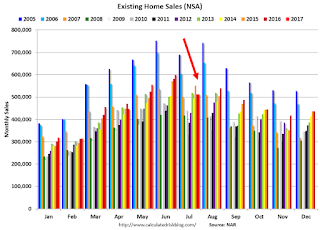by Calculated Risk on 8/24/2017 02:20:00 PM
Thursday, August 24, 2017
A Few Comments on July Existing Home Sales
Earlier: NAR: "Existing-Home Sales Slide 1.3 Percent in July"
First, as usual, housing economist Tom Lawler's estimate was much closer to the NAR report than the consensus. So the decline in sales in July was no surprise for CR readers.
Inventory is still very low and falling year-over-year (down 9.0% year-over-year in July). Inventory has declined year-over-year for 26 consecutive months. I started the year expecting inventory would be increasing year-over-year by the end of 2017. That now seems unlikely.
Inventory is a key metric to watch. More inventory would probably mean smaller price increases, and less inventory somewhat larger price increases.
The following graph shows existing home sales Not Seasonally Adjusted (NSA).

Sales NSA in July (red column) were the same as July 2016. (NSA).
Note that sales NSA are now in the seasonally strong period (March through September).
And here is another update to the "distressing gap" graph that I first started posting a number of years ago to show the emerging gap caused by distressed sales. Now I'm looking for the gap to close over the next several years.

Following the housing bubble and bust, the "distressing gap" appeared mostly because of distressed sales. The gap has persisted even though distressed sales are down significantly, since new home builders focused on more expensive homes.
I expect existing home sales to move more sideways, and I expect this gap to slowly close, mostly from an increase in new home sales.
However, this assumes that the builders will offer some smaller, less expensive homes. If not, then the gap will persist.

This ratio was fairly stable from 1994 through 2006, and then the flood of distressed sales kept the number of existing home sales elevated and depressed new home sales. (Note: This ratio was fairly stable back to the early '70s, but I only have annual data for the earlier years).
In general the ratio has been trending down since the housing bust, and this ratio will probably continue to trend down over the next several years.
Note: Existing home sales are counted when transactions are closed, and new home sales are counted when contracts are signed. So the timing of sales is different.


